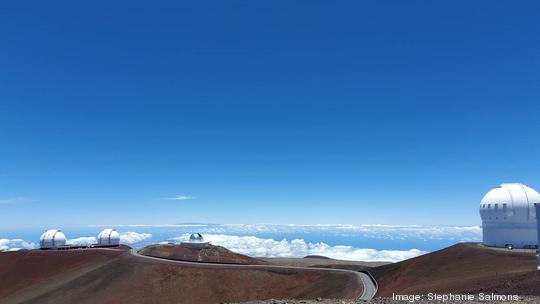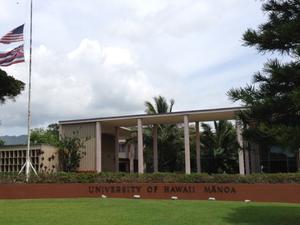
The University of Hawaii is in the early stages of establishing a space engineering and instrument development center at the UH Institute for Astronomy’s facilities on the UH-Hilo campus, it was recently announced.
"The Space Sciences Initiative is expected to attract millions of dollars in funding, expand Hawaii's technology sector and create more high-paying jobs on Hawaii Island and across the state," a Jan. 7 announcement from UH noted.
UH received $2 million in state funds to start the initial design of the facility, which is currently estimated to cost about $30 million to $40 million to construct, according to the announcement, which said, too, that UH students will receive "valuable hands-on training at the center producing instruments for space-based missions and ground-based telescopes. "
While ground observatories, including those in Hawaii, regularly spend tens of millions of dollars to upgrade equipment and build instrumentation, those engineering efforts typically occur outside of the Islands, the announcement noted. The planned facility, however, will be designed to bring more of that activity to Hawaii.
"The additive manufacturing and precision machining capabilities of the center and its personnel will also be able to support the Pearl Harbor Naval Shipyard and other Department of Defense entities as well as aerospace and private sector partners," the announcement read.
“The components of a successful center of this type already exist at UH, and this new initiative is helping to cohesively and effectively bring them together,” UH Vice President of Research and Innovation Vassilis Syrmos said in a statement. “We are on the verge of investing in place-based research and training of our students and faculty on Hawaii Island, where space engineering and advanced manufacturing are at the forefront of a high-tech industry that can support a locally based, well-educated and highly paid workforce.”
The center is an interdisciplinary collaboration between the UH Institute for Astronomy, or IfA, UH-Hilo and the UH Manoa College of Engineering, or COE.
According to the announcement, IfA astronomers and engineers are already developing "some of the most advanced astronomical instruments in the world," including:
- Near-infrared sensors on the James Webb Space Telescope
- Adaptive secondary mirrors with broad applications in telescopes
- Software for the NASA Nancy Grace Roman Space Telescope to process thousands of observations of supernovae or exploding stars
- A new instrument that provides adaptive optics correction using objects invisible to the naked eye.
“This is a natural fit as Hawaii is home to the best astronomy sites in the world and one of the world’s best research universities,” COE Dean Brennon Morioka said in a statement. “UH is now among just a handful of universities developing an on-campus, astronomical manufacturing center and it will have a far-reaching impact on our students, our state and beyond.”
According to the university, construction on the center is tentatively scheduled to be completed by 2030, but is subject to securing funding for the construction phase. Meanwhile, the associated academic programming will begin in the 2024 fall semester.
UH-Hilo will begin an initial offering of pre-engineering courses while the new high-tech manufacturing center is developed, the announcement noted.
“The launch of the Space Sciences Initiative will provide valuable opportunities for UH-Hilo and our students thanks to this collaboration with UH Manoa and the UH system,” UH-Hilo Chancellor Bonnie Irwin said in a statement. “It expands our academic offerings that will in turn create more career opportunities for our students, especially those from Hawaii Island.”
According to the announcement, 10 new full-time faculty are now being recruited to teach the prerequisite engineering courses at UH-Hilo and serve as the core engineering team for the new center.
Five of the new faculty will be located at IfA’s Hilo facility, the university said, while the rest will be located at the COE at UH Manoa. UH Hilo students can transfer those credits to UH Manoa, where they can go on and complete their engineering degrees, according to the announcement.
There are approximately 500 jobs at observatories on Mauna Kea and Haleakala that are held by engineers and technicians who specialize in optics, software, data science, materials, mechanics, systems and cryogenics, the university said.
“UH-Hilo students are predominantly from Hawaii Island and now they will have an academic pathway into engineering and ultimately careers that support Hawaii observatories,” IfA Director Doug Simons said in a statement. “Right now, these well-paying jobs too often go to non-residents, who are more likely to leave after a few years. We want these jobs to go to local kids. That will not only be good for them and their families, it will increase stability in the astronomy sector and broadly benefit our community.”
The astronomy sector employed 1,313 Hawaii residents and had a total economic impact of $221 million in 2019, according to a 2022 update from the University of Hawaii Economic Research Organization, or UHERO.






